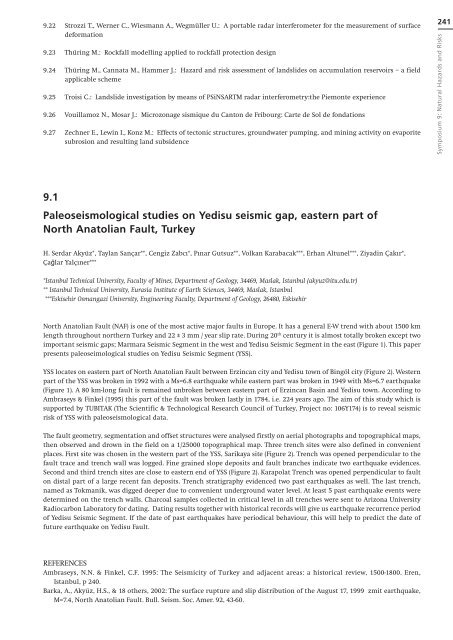Open Session - SWISS GEOSCIENCE MEETINGs
Open Session - SWISS GEOSCIENCE MEETINGs
Open Session - SWISS GEOSCIENCE MEETINGs
You also want an ePaper? Increase the reach of your titles
YUMPU automatically turns print PDFs into web optimized ePapers that Google loves.
9.22 Strozzi T., Werner C., Wiesmann A., Wegmüller U.: A portable radar interferometer for the measurement of surface<br />
deformation<br />
9.23 Thüring M.: Rockfall modelling applied to rockfall protection design<br />
9.24 Thüring M., Cannata M., Hammer J.: Hazard and risk assessment of landslides on accumulation reservoirs – a field<br />
applicable scheme<br />
9.25 Troisi C.: Landslide investigation by means of PSiNSARTM radar interferometry:the Piemonte experience<br />
9.26 Vouillamoz N., Mosar J.: Microzonage sismique du Canton de Fribourg: Carte de Sol de fondations<br />
9.27 Zechner E., Lewin I., Konz M.: Effects of tectonic structures, groundwater pumping, and mining activity on evaporite<br />
subrosion and resulting land subsidence<br />
.1<br />
Paleoseismological studies on Yedisu seismic gap, eastern part of<br />
North Anatolian Fault, Turkey<br />
H. Serdar Akyüz*, Taylan Sançar**, Cengiz Zabcı*, Pınar Gutsuz**, Volkan Karabacak***, Erhan Altunel***, Ziyadin Çakır*,<br />
Çağlar Yalçıner***<br />
*Istanbul Technical University, Faculty of Mines, Department of Geology, 34469, Maslak, Istanbul (akyuz@itu.edu.tr)<br />
** Istanbul Technical University, Eurasia Institute of Earth Sciences, 34469, Maslak, Istanbul<br />
***Eskisehir Osmangazi University, Engineering Faculty, Department of Geology, 26480, Eskisehir<br />
North Anatolian Fault (NAF) is one of the most active major faults in Europe. It has a general E-W trend with about 1500 km<br />
length throughout northern Turkey and 22 ± 3 mm / year slip rate. During 20 th century it is almost totally broken except two<br />
important seismic gaps; Marmara Seismic Segment in the west and Yedisu Seismic Segment in the east (Figure 1). This paper<br />
presents paleoseimological studies on Yedisu Seismic Segment (YSS).<br />
YSS locates on eastern part of North Anatolian Fault between Erzincan city and Yedisu town of Bingöl city (Figure 2). Western<br />
part of the YSS was broken in 1992 with a Ms=6.8 earthquake while eastern part was broken in 1949 with Ms=6.7 earthquake<br />
(Figure 1). A 80 km-long fault is remained unbroken between eastern part of Erzincan Basin and Yedisu town. According to<br />
Ambraseys & Finkel (1995) this part of the fault was broken lastly in 1784, i.e. 224 years ago. The aim of this study which is<br />
supported by TUBITAK (The Scientific & Technological Research Council of Turkey, Project no: 106Y174) is to reveal seismic<br />
risk of YSS with paleoseismological data.<br />
The fault geometry, segmentation and offset structures were analysed firstly on aerial photographs and topographical maps,<br />
then observed and drown in the field on a 1/25000 topographical map. Three trench sites were also defined in convenient<br />
places. First site was chosen in the western part of the YSS, Sarikaya site (Figure 2). Trench was opened perpendicular to the<br />
fault trace and trench wall was logged. Fine grained slope deposits and fault branches indicate two earthquake evidences.<br />
Second and third trench sites are close to eastern end of YSS (Figure 2). Karapolat Trench was opened perpendicular to fault<br />
on distal part of a large recent fan deposits. Trench stratigraphy evidenced two past earthquakes as well. The last trench,<br />
named as Tokmanik, was digged deeper due to convenient underground water level. At least 5 past earthquake events were<br />
determined on the trench walls. Charcoal samples collected in critical level in all trenches were sent to Arizona University<br />
Radiocarbon Laboratory for dating. Dating results together with historical records will give us earthquake recurrence period<br />
of Yedisu Seismic Segment. If the date of past earthquakes have periodical behaviour, this will help to predict the date of<br />
future earthquake on Yedisu Fault.<br />
REFERENCES<br />
Ambraseys, N.N. & Finkel, C.F. 1995: The Seismicity of Turkey and adjacent areas: a historical review, 1500-1800. Eren,<br />
Istanbul, p 240.<br />
Barka, A., Akyüz, H.S., & 18 others, 2002: The surface rupture and slip distribution of the August 17, 1999 ²zmit earthquake,<br />
M=7.4, North Anatolian Fault. Bull. Seism. Soc. Amer. 92, 43-60.<br />
2 1<br />
Symposium 9: Natural Hazards and Risks









